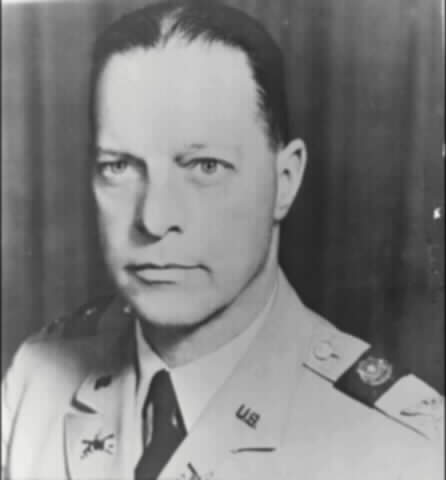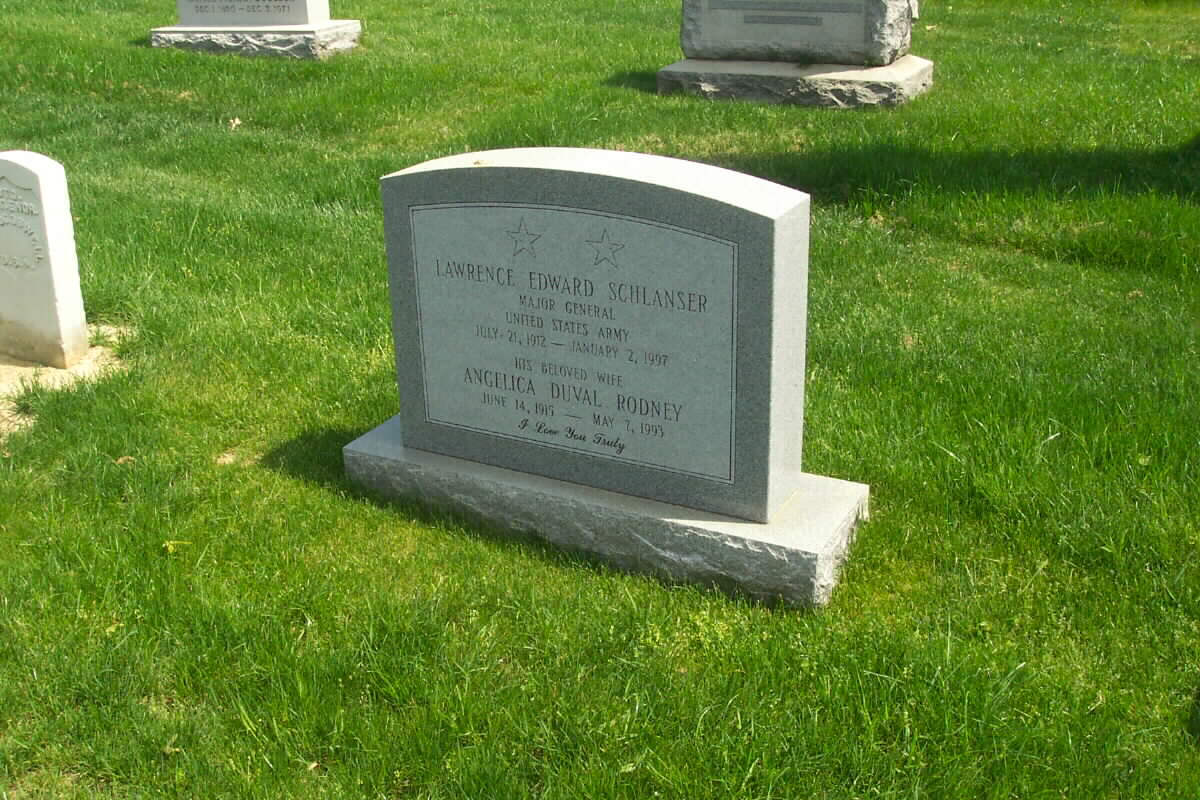Courtesy of the United States Military Academy
MG Lawrence Edward Schlanser
United States Army • No. 10360 • Class of 1935
Died January 2, 1997, in Washington, DC, at the age of 85
LAWRENCE EDWARD “BUD” SCHLANSER was born at Fort Shafter, Hawaii, and was active in all areas of cadet life. Due to his upbringing in the Army, he was well acquainted with several families on post. Socially, he was in demand for picnics, dinner parties, and as an escort for cadet hops, sharing these functions with his classmates. He devoted all four cadet years, in season, to ice hockey and that old Indian frolic — lacrosse. In 1937, he married Angelica (Jill) Rodney.
Having been favorably accepted by horses in his formative years, Schlanser chose the Cavalry. After graduation leave, he reported to Fort Riley, where he was assigned to the 13th and 2d Cavalry Regiments. This service in horse cavalry units did not prevent him from making an impressive showing as commanding officer of the Reconnaissance Troop of an experimental Mechanized Brigade during the 1941 Louisiana Maneuvers.
During World War II, he commanded the 19th Cavalry Recon Squadron (Mech), serving with distinction through the Central European and Rhineland Campaigns. In the final drive to the Rhine, he was seriously wounded when, while scouting in front of his unit, his jeep was destroyed by a land mine. Following his recovery, he rejoined his squadron and moved with it to Fort Campbell, Kentucky.
Schlanser’s next assignment was to Fort Bragg, North Carolina, as executive officer of the Communications and Electronics Section. He became deeply involved in research and development of communications and electronic technologies and their subsequent applications to the Army’s needs. He then served a second tour in Europe as commander of the 1st Constabulary Squadron of the 15th Armored Cavalry Regiment. Following a three year hitch in the Pentagon, he went to the 24th Infantry Division in Korea as chief of staff. He then served as G-3 of the Eighth Army in Seoul. In 1955, he was appointed as the Director of the Combat Developments Group of the Armor School at Fort Knox. He prepared and delivered two of the major U.S. policy presentations at the 1957 Armor Tripartite Conference in Quebec. His efforts contributed substantially to the ability of the U.S. Army to accomplish its vital role on any future battlefield.
In 1959, he returned to Europe as commander of the 2nd Armored Cavalry Regiment. Upon his promotion to Brigadier General in 1962, Schlanser was detailed to the U.S. Army Test and Evaluation Command as Deputy Commanding General. His distinguished service led to his promotion to Major General in 1965, with duty as Chief of Staff of the Eighth Army in Seoul, Korea. In 1967, he was reassigned to Heidelberg, Germany, as Commanding General, Seventh Army Support Command and, subsequently, as Commanding General of the VII Corps Support Command. In these capacities, he was cited for “profound leadership ability, truly outstanding professional competence, unique managerial skill, and great ingenuity” in restructuring and modernizing Seventh Army’s logistic support to U.S. combat forces. Schlanser retired in June 1970.
During his 35 years of active duty, he was awarded 17 citations and decorations, including the Purple Heart, the Bronze Star Medal for Valor, the Legion of Merit, the Distinguished Service Medal, and the (Korean) Ulchi Distinguished Military Service Medal with Gold Star. He was a graduate of the Cavalry School (three courses), the Infantry School, the Armor School (two courses), Command and General Staff College, the Armed Forces Staff College, and the Army War College. His professional knowledge, in combination with his demonstrated energy, dependability, judgment, and ability, always enabled him to produce outstanding results.
During his retirement years, Schlanser lived in Annandale, Virginia. He remained active, serving two three-year tours as chairman of the Class of ’35 executive committee and as its permanent Reunion Chairman. For 16 years he was vice chairman of the U.S. Horse Cavalry Association. The U.S. Armor Association recognized his contributions by awarding him both the Silver and Gold Medallions of its Order of Saint George. He also was appointed “Honorary Colonel” of the 2d Armored Cavalry Regiment. These awards reflected his lifetime commitment to sustaining and increasing, in the age of mechanization, the mobility, firepower, and shock action that have been the Cavalry’s historic contribution to land warfare.
Michael Robert Patterson was born in Arlington and is the son of a former officer of the US Army. So it was no wonder that sooner or later his interests drew him to American history and especially to American military history. Many of his articles can be found on renowned portals like the New York Times, Washingtonpost or Wikipedia.
Reviewed by: Michael Howard


